Prime
Manage your layers with wooden nesting boxes

Layer birds resting in the wooden cages. Photo by George Katongole.
What you need to know:
- SUMMARY: Finding ways to cut costs on the farm by making or designating items for poultry farming can boost the family budget. One option is to use materials from around the farm into chicken nesting boxes, writes George Katongole.
Rose Akol, a poultry farmer in Kakira has found a new way to reduce labour at her farm by using wooden nesting boxes for her layers.
The 44-year old Akol, a mother of six, told Seeds of Gold that poultry has been her core business for more than ten years and she has been finding ways of making it more productive.
After farm visits, she found one farmer who was efficient in egg collection. According to her, she also started keeping layers in cages.
About the nesting boxes
According to Akol, the basic purpose of nesting boxes is to encourage hens to lay their eggs in a clean cubicle in relative peace and privacy. Although chickens are not particular about where they lay their eggs, a suitable nest box in which to lay eggs can make the hunt for eggs easy.
She was aware of steel battery cages but did not have enough money to purchase one.
Her wooden cages are homemade with each estimated to cost about Shs60,000 when finished. Using low quality wood, the cabins are measured one square foot with each cage accommodating 20 nests.
She fills the nests with coffee husks as bedding materials to give a soft landing for laid eggs.
In her chicken house, Akol has three cages strategically positioned to allow chicken enough space. She says that regular cleaning of the cubicle is also important.
Teaching the chicken
Akol says that the most important thing is to provide the right number of nest boxes.
After two months, the nests are brought into the chicken house such that chicken do not find it a strange object later.
Akol says that one can use rejected eggs and place them in a nest box to give the chicken a hint that the boxes are the place to lay their eggs too.
She recommends that since chicken are confined in the house all their life, boxes must appear a natural habitat.
She says that it is important to replace the beddings regularly such that you encourage your hens to lay there rather than elsewhere.
For the stubborn hens, Akol recommends that you gently grab them and move them into an empty nest. Sooner or later, they will get tired of being disturbed and start laying into an empty nest.
Advantages of cages
According to Akol, eggs laid in cages are not contaminated which reduces the incidence of diseases spread through droppings.
She also says that it lowers the cost of production. For instance, in her chicken house, 600 birds are attended to by one person who collects the eggs in little time.




